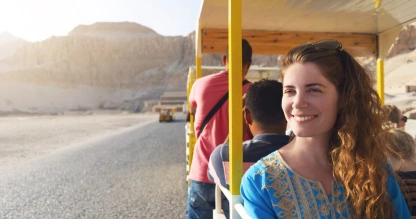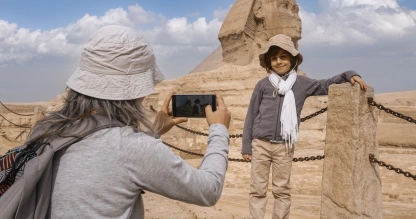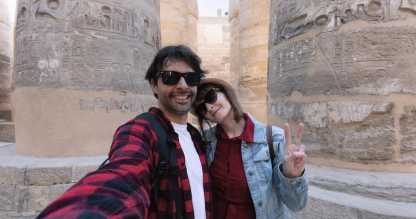Sakkara: Unraveling the Mysteries of the Ancient Majesty
Located about 30 kilometers south of modern-day Cairo, Sakkara is one of the most fascinating archaeological sites in Egypt. As the final resting place of pharaohs, queens, and officials from the Old Kingdom, Sakkara is steeped in history and intrigue. Its vast necropolis, replete with royal tombs, sacred temples, and countless artifacts, bears witness to the grandeur and complexity of ancient Egyptian civilization.
Although less frequented than the famous Giza Plateau, Sakkara is no less significant. Indeed, its sprawling burial ground, which served as the necropolis for the ancient capital of Memphis, is a treasure trove of historical and architectural gems. From the iconic Step Pyramid of Djoser to the myriad mastabas adorned with exquisite frescoes, Sakkara is a testament to the ingenuity and artistic mastery of its ancient builders.
Sakkara's rich tapestry of ancient relics is not only a veritable open-air museum but also a window into the spiritual and cultural life of the Old Kingdom. Its tombs and temples, in their various states of preservation, invite us to step back in time and immerse ourselves in the mysteries of this ancient majesty.
The Historical Significance of Sakkara
Sakkara's historical significance cannot be overstated. As the principal burial site for the pharaohs of the Old Kingdom, it was a place of immense religious and political importance. The construction of mastabas and pyramids not only signified the transition from life to death but also reaffirmed the pharaoh's divine status and power.
Moreover, Sakkara's necropolis was not just a repository of royal tombs. It was also a complex socio-economic system that involved a vast workforce of architects, engineers, artisans, and laborers, as well as an elaborate network of supply chains for food, materials, and other resources. The construction and maintenance of these massive structures were a testament to the administrative prowess of the Old Kingdom.
Sakkara's historical significance is further underscored by its extensive array of texts and inscriptions. These provide invaluable insights into the religious beliefs, social customs, and political dynamics of the period. Whether etched on tomb walls or inscribed on papyrus scrolls, these texts are a rich source of information for historians, archaeologists, and Egyptologists alike.

The Architectural Marvels of Sakkara
The architectural marvels of Sakkara are as diverse as they are impressive. At the heart of the necropolis stands the Step Pyramid of Djoser, the world's oldest complete stone building. Built by the famed architect Imhotep, this revolutionary structure marked a critical shift from the traditional mastaba design to a more ambitious, pyramid-shaped monument.
The Step Pyramid, however, is just one of many architectural masterpieces in Sakkara. Scattered across the necropolis are numerous mastabas, or flat-roofed tombs, each with its unique design and decorations. These range from simple mud-brick structures to elaborate stone edifices adorned with intricate bas-reliefs and vivid wall paintings.
Among the most remarkable of these is the Mastaba of Ti, a high official of the Fifth Dynasty. This tomb is renowned for its detailed scenes of everyday life, from agriculture and hunting to music and dance, which offer a fascinating glimpse into the world of the Old Kingdom.

The Mysteries Surrounding Sakkara
Despite centuries of exploration and study, Sakkara continues to be shrouded in mystery. Many of its tombs and temples remain unexcavated, and countless artifacts are yet to be discovered. Even the known structures, such as the Step Pyramid and the Serapeum, pose a multitude of questions about their construction, function, and symbolic significance.
One of the most enigmatic features of Sakkara is the Serapeum, a subterranean complex believed to be the burial place of the Apis bulls, sacred animals associated with the god Ptah. The purpose of this massive labyrinth, with its colossal granite sarcophagi, remains a subject of debate among scholars.
Similarly intriguing is the Pyramid Texts, the earliest known corpus of religious texts, found in the pyramid of Unas and later pharaohs. These inscriptions, which deal with the afterlife and the pharaoh's ascension to the heavens, are a rich source of information but also raise many questions about the beliefs and rituals of the period.

Noteworthy Monuments and Landmarks in Sakkara
In addition to the Step Pyramid and the Serapeum, Sakkara boasts a wealth of other noteworthy monuments and landmarks. These include the Pyramid of Teti, the second king of the Sixth Dynasty, notable for its Pyramid Texts, and the nearby mastaba of his queen, Iput.
Another must-see is the Pyramid of Userkaf, the founder of the Fifth Dynasty. Although much smaller than its Sixth Dynasty counterparts, this pyramid is unique for its sun temple, a feature not found in other pyramids at Sakkara.
Also worth visiting is the Tomb of Mereruka, the largest and most lavishly decorated mastaba in Sakkara. With its 32 rooms filled with beautiful reliefs depicting scenes from Mereruka's life and the afterlife, this tomb is a true masterpiece of ancient Egyptian art.

Archaeological Excavations and Discoveries in Sakkara
Sakkara has been a hotbed of archaeological activity since the 19th century, yielding a plethora of discoveries that have greatly enriched our understanding of ancient Egypt. From royal tombs and sacred temples to priceless artifacts and ancient texts, these findings have shed light on various aspects of the civilization, from its architectural prowess to its religious beliefs and social customs.
One of the most significant discoveries in Sakkara is the Serapeum, found by the French archaeologist Auguste Mariette in 1850. This subterranean complex, with its giant sarcophagi and intricate reliefs, offered valuable insights into the cult of the Apis bull and the religious practices of the period.
More recently, in 2020, a team of Egyptian archaeologists unearthed more than 100 sealed coffins and a trove of golden artifacts at the Saqqara necropolis. This major find, dubbed the "Saqqara sensation," is considered one of the largest and most important discoveries in recent years.

Happy Travellers with Cairo Nile Cruise!
Take a look at our top Egypt Tours reviews, where you will find firsthand insights from our very own Intrepid travellers.









